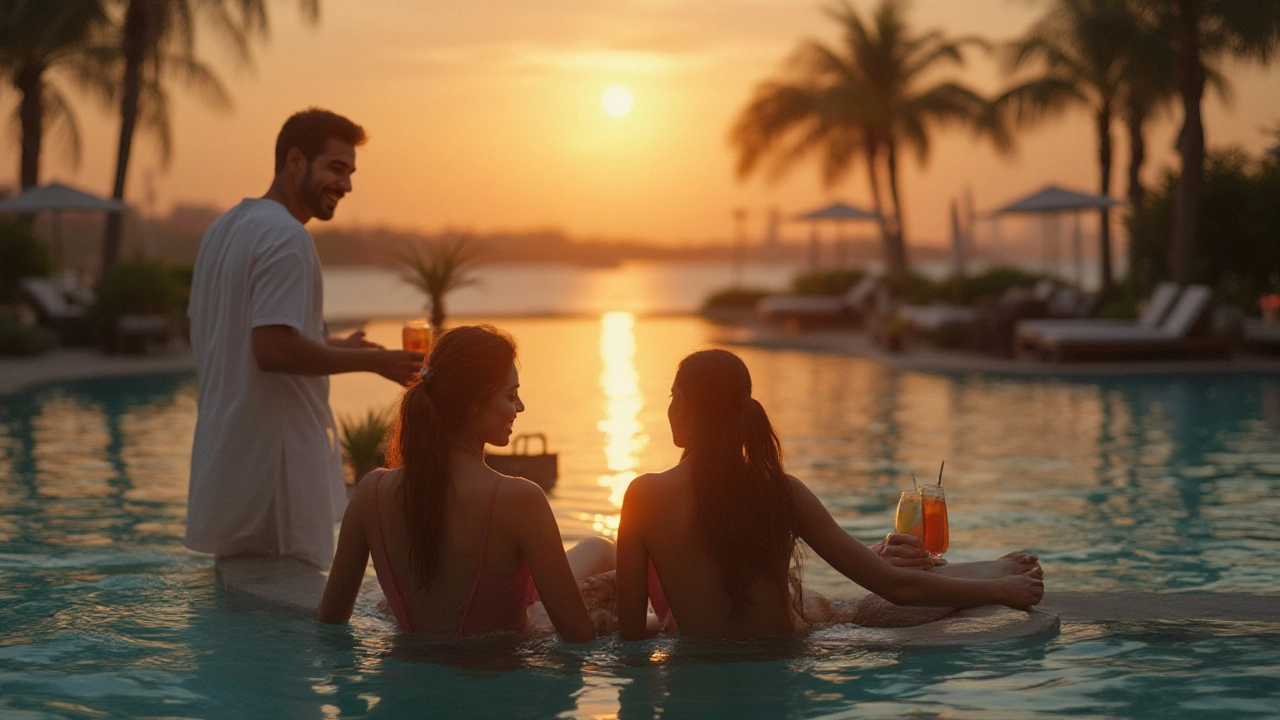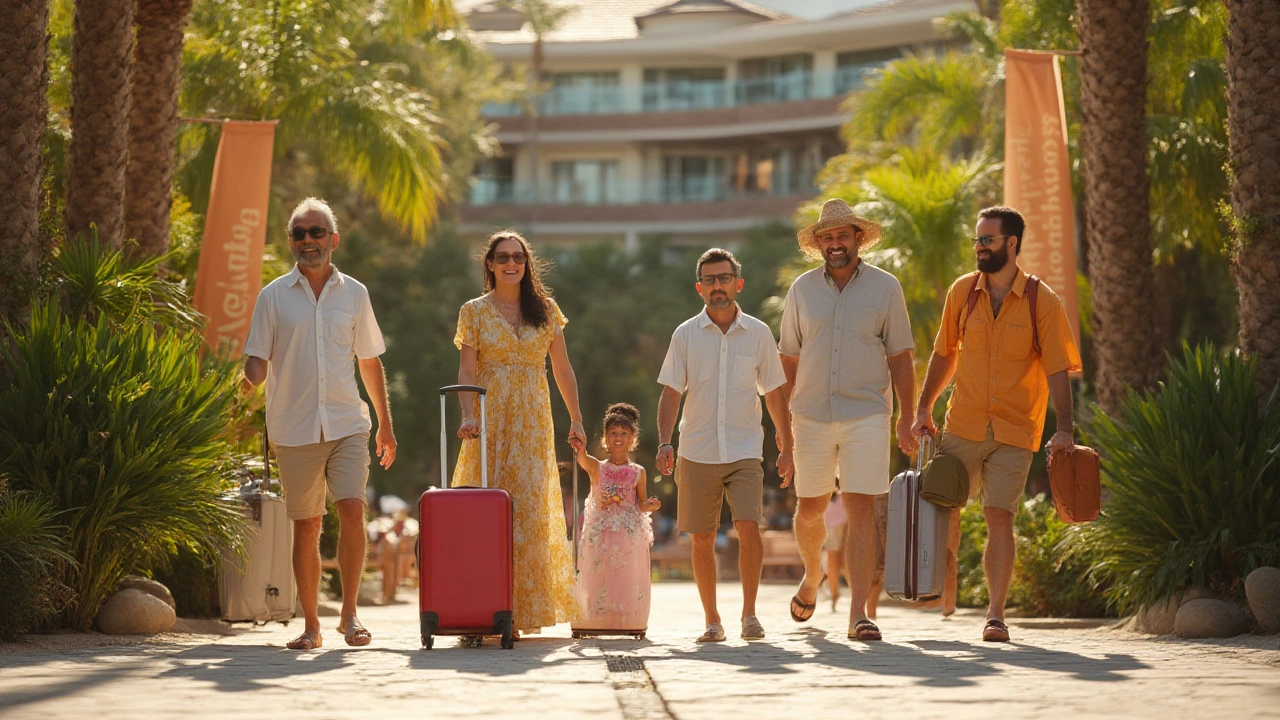Picture this: You roll out of bed, slip on your flip-flops, and stroll to breakfast, knowing it’s already paid for. You order the extra pancakes, because why not? No wallet. No tipping anxiety. No bill to sign. Just carefree eating, drinking, and playing. That’s the magic of the all-inclusive vacation—and what keeps people dreaming of the Caribbean or Mexico. But here’s the thing: do you really have to hop on a plane, show your passport, and battle customs just to get that all-in-one luxury? Or can you score those perks right at home in the United States? The truth might surprise you.
The All-Inclusive Concept in the US: Fact vs. Fiction
People often assume all-inclusives mean sandy beaches and umbrella drinks south of the border. The U.S. doesn’t pop up in those daydreams. Why? Because the all-inclusive model hasn’t been as popular or as widespread here—at least, not in the same way as Mexico or the Caribbean. Europe too, for that matter. But, yes, all-inclusive hotels DO exist in the United States. They just play by different rules and look a bit different.
The U.S. hospitality industry tends to break out costs—think resort fees, food, activities—as extra line items. American travelers are used to tipping and choosing à la carte. That said, a handful of places buck the trend and roll everything into one price, so you know what you’ll spend upfront. Some even go all in: lodging, meals, drinks, activities, kids’ programs, taxes, gratuities, and more, are wrapped into one rate. Others fudge the definition a bit, calling themselves "full board" (three meals a day, but not always drinks) or "inclusive" with limits.
So why haven’t all-inclusives taken over in the US? Part of it’s cultural. Part’s about labor and liquor laws—booze included in one set price can get tricky, state by state. And part of it comes down to simple economics: lots of travelers want to branch out, explore restaurants in a new city, and feel less locked in to a single resort. Still, those all-inclusive resorts that DO operate stateside are popular, and sometimes even sold out months ahead.
Where to Find All-Inclusive Hotels Across America
If you’re set on having meals, drinks, and fun bundled together, you have real options, but you won’t find them lining every major highway or beach. In the US, all-inclusive hotels often pop up in spots where you’ll spend most of your trip on-property. Think big nature, not big city: islands, national parks, remote beaches, and lakes are popular backdrops. Ski resorts and ranches are part of the all-inclusive story, too.
Here’s a short list of the kinds of places you’ll encounter:
- Family Resorts: Think Club Med Sandpiper Bay in Florida. It’s probably the US’s most famous true all-inclusive, with kids’ clubs, activities, and meals galore.
- Luxury All-Inclusives: Places like Little Palm Island Resort & Spa in the Florida Keys, Twin Farms in Vermont, and Miraval in Arizona. These amp up the style and service (with the price to match), covering gourmet dining, spa credits, activities, and more.
- Dude Ranches: Western experiences like Colorado’s C Lazy U Ranch or Montana’s The Ranch at Rock Creek. They’ll keep you busy with horseback riding, fishing, and s’mores. Most use the all-inclusive format—meals, activities, and even gear in one price.
- Ski Resorts: Some, like Woodloch Resort in Pennsylvania, offer winter packages where meals, accommodations, and lots of cold-weather fun (ice skating, snow tubing) are all covered.
- Wellness and Spa Resorts: Miraval is the big name in this space. Canyon Ranch, too. They include meals, classes, and resort credits.
The best tip? Always read the fine print. Some “all-inclusive” claims really mean just breakfast, or "activities included but drinks are extra." Make sure meals, alcohol (if you care), gratuities, water sports, and the like are actually included. Here’s a quick comparison of some of the most popular U.S. all-inclusives:
| Resort | State | Family Friendly | Drinks Included? | Main Activities |
|---|---|---|---|---|
| Club Med Sandpiper Bay | Florida | Yes | Yes | Sports, kids’ programs, pools |
| The Ranch at Rock Creek | Montana | Yes | Yes | Horseback riding, hiking, archery |
| Miraval Arizona | Arizona | Adults Only | No (limited) | Wellness, fitness, spa |
| Mohonk Mountain House | New York | Yes | Non-alcoholic only | Hiking, skating, boating |
| Little Palm Island Resort | Florida | No | Yes | Luxury, water sports, spa |
If you want classic “Caribbean-style” all-inclusive, Club Med is basically the only big international chain with a U.S. outpost. But homegrown luxury resorts do inclusivity their own way—even if you’re paying $1,000 a night, it’s all covered.

What’s Actually Included? Breaking Down the Perks (and the Fine Print)
Here’s where things get a little wild: there’s no ironclad definition of “all-inclusive” in the US. Each resort decides which perks to offer. Some toss in premium liquor, daily spa credits, and even airport transfers. Others charge for extras like certain activities or exclusive dinners.
Here’s what you might find rolled into your nightly rate (but always double-check):
- Three meals a day (sometimes snacks and 24-hour room service too)
- Alcoholic beverages (varies whether it’s just well drinks, or top-shelf too)
- Non-alcoholic drinks all day
- Access to pools, fitness centers, and basic on-site activities
- Certain water sports or equipment use (kayaks, paddleboards, bikes)
- Kids’ clubs, organized games, or family-friendly activities
- Nightly entertainment
- Some resorts include guided hikes, fitness classes, yoga, meditation
- Taxes and tips—some places actually say “Don’t tip. It’s included.”
Large family resorts usually focus on activities and food, while wellness resorts lean hard into spa treatments, healthy dining, and unplugging from tech. Dude ranches? They’ll fill your schedule with cowboy breakfasts and trail rides. The main thing is: call before you book. Don’t assume every activity comes free—horseback riding or golf might cost extra, and ultra-fancy dinners almost always do.
Some homegrown all-inclusives let you customize your stay. For example, you might pick a “spa inclusive” package or a “gourmet inclusive" deal, but if you want wine pairings or a fancier room, expect surcharges. Drinks, too—in some dry counties, alcohol’s never included. And there’s sometimes a resort fee even at a resort that touts everything’s all-covered. Sneaky.
If you spot a place calling itself “half board,” you’re only getting breakfast and dinner. “Full board” is three meals (but not snacks or alcohol). Anything fancier? That’s when you’re looking at the true all-inclusive.
Are All-Inclusive Resorts in the US Worth It?
So, is it worth hunting down these American all-inclusives? Here’s where you zoom out and do some math. Yes, the sticker shock at first glance can be brutal—some of these spots charge $600 to $2,000 a night for two adults. But now picture adding up gourmet meals, drinks, activities, kids’ camp, daily cleaning, and gratuities at a regular hotel. Chances are, it’ll get close.
When you visit an expensive destination—like the Florida Keys, Aspen, or rural Vermont—buying meals and activities one-by-one can get very pricey. Properties like Mohonk Mountain House in New York, for example, look expensive at first, but when you factor in everything they bundle (three meals, endless kids’ activities, outdoor gear, taxes, gratuities), it’s not so crazy.
There’s also a time-versus-money thing. An all-inclusive trip means zero planning once you’re there. You’re not squinting at Yelp, stressing about each tab, or roaming for the next meal. You pay upfront and can relax—and eat the extra dessert if you want.
Parents swear by all-inclusives because of the simplicity with kids. One price for everyone, built-in childcare and activities, picky eaters are covered, and you’re not reaching for your wallet every five minutes. That’s why you see big reunions and multi-generational groups at these resorts.
If you love sampling dozens of restaurants and bar-hopping, or you’re itching to explore every corner of a new city, this model’s probably not as fun. But the folks who check in, stay put, and make the most of everything that’s included? They’re getting major value.

Tips for Booking and Getting the Best All-Inclusive Value in the US
Let’s talk strategy. With all-inclusives stateside, you need to be a careful shopper and maximize what you get for the money. Here’s what to look out for:
- Compare packages: Some resorts let you pick from different all-inclusive tiers—meals only, meals plus activities, or full everything. Run the numbers before you book.
- Check alcohol rules: Will you have to pay for premium cocktails? Is the resort in a county with alcohol restrictions? If you care about drinks, pay close attention to this perk.
- Watch for surcharges: Sushi night, fancier restaurants, spa treatments, golf, and private guides usually cost extra, even at “full” all-inclusives.
- Book early: Especially for school vacations, resorts like Club Med Sandpiper Bay are fully sold out months ahead. Families planning summer or winter break should look half a year out.
- Ask about special events: Some resorts offer themed weekends, festivals, or special family events included in the rate—others don’t. Ask when you’re booking.
- Consider the season: Ski resorts with all-inclusive packages are much cheaper in summer. In the Northeast, autumn brings leaf-peeping value, while the coldest months are priciest at top winter resorts.
- Pack smart: While most activities are included, some gear isn’t. Ranches might loan basic boots or hats, but plan to bring layers, swimwear, and anything specific to your trip.
- Read cancellation and refund policies: Packages are often stricter on cancellations, and changes might cost you. Check all the terms before booking.
One last pro tip—many of these properties have loyalty programs or special offers for returning guests. If you fall for the all-inclusive style, you can sometimes lock in lower rates or bonus perks in future years, especially at the family owned resorts in New York, Vermont, Pennsylvania, or Montana.
So, does the United States have all-inclusive hotels? Yes—and the experience is probably better than you expect. It isn’t the mega-resort buffet scene you see in Cancún or Punta Cana. It’s something a little more personal, a little more unique. And if you know where to look and what questions to ask, you can find true all-inclusivity, right here at home.
